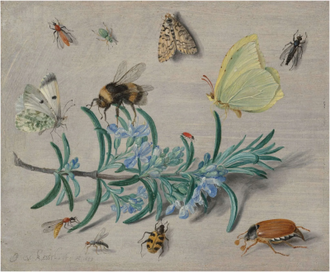Gospel in Art: For you tithe mint and dill and cumin...

Insects and a Sprig of Rosemary by Jan van Kessel the Elder, 1653, Oil on copper © National Gallery of Art, Washington
Source: Christian Art
Gospel of 26 August 2025
Matthew 23:23-26
At that time: Jesus said, 'Woe to you, scribes and Pharisees, hypocrites! For you tithe mint and dill and cumin, and have neglected the weightier matters of the law: justice and mercy and faithfulness. These you ought to have done, without neglecting the others. You blind guides, straining out a gnat and swallowing a camel!
'Woe to you, scribes and Pharisees, hypocrites! For you clean the outside of the cup and the plate, but inside they are full of greed and self-indulgence. You blind Pharisee! First clean the inside of the cup and the plate, that the outside also may be clean.'
Reflection on the painting
In Jesus' day, there were hundreds of religious rules to keep, covering everything from worship to what you ate. In today's gospel, Jesus points out that some people were getting their priorities all wrong. They were scrupulously measuring out tiny portions of herbs-mint, dill, and cumin-to make sure they gave exactly the right amount to God, yet they were neglecting what He calls the "weightier matters" of the Law: justice, mercy, and faith. It's not that the herbs didn't matter, but they were missing the heart of it all.
For Jesus, justice, mercy, and faith are the foundation stones of a life with God. Justice and mercy are about how we treat others: standing up for what is right, and showing compassion even when it is costly. Faith is about our relationship with God: trusting Him, following Jesus, and living by what He taught. The three belong together: our faith in God should naturally lead us to act with justice and mercy toward others. Without them, even the most careful rule-keeping is empty.
By the Middle Ages, herbs had moved far beyond their biblical role as simple food flavourings. They became a major focus of study, prized for their medicinal properties. Monastic gardens across Europe were carefully planted with mint for digestion, rosemary for memory, lavender for calming the nerves, and dozens more. Herbal manuscripts and "physick" books circulated widely, and the fascination spread into the visual arts. Artists began including herbs in their work not only because they were fashionable, but also because each plant carried symbolic meaning. For example, rosemary was linked to remembrance and fidelity, while thyme was associated with courage.
This interest carried into the 17th century, when painters used herbs to weave together beauty, science, and symbolism. Few did this with more delicate precision than Jan van Kessel the Elder. His Insects and a Sprig of Rosemary, painted in 1653, is a tiny jewel of oil on copper. Against a simple background, he paints a single sprig of rosemary, its blue-green leaves meticulously rendered, surrounded by butterflies, beetles, and other insects. It is a quiet, meditative image: the herb standing as a symbol of memory and constancy, while the insects speak of the fragility and fleetingness of life. In van Kessel's hands, a humble herb becomes almost a theological reminder.
LINKS
Gospel in Art: https://christian.art/
Today's Reflection: https://christian.art/daily-gospel-reading/matthew-23-23-26-2025/


















